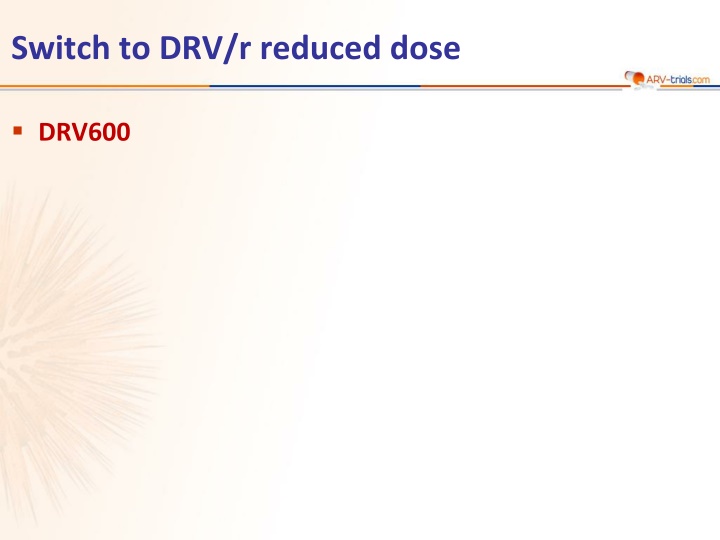
Study on Switching to DRV/r Reduced Dose DRV600
This study investigates the efficacy and safety of switching to DRV/r reduced dose DRV600 in HIV patients who were previously on DRV/r 800/100 mg. The study analyzes various endpoints including treatment success at week 48, virologic efficacy, pharmacokinetics, and cost-effectiveness. Results show no treatment failure in the observed population, with favorable safety profiles and no emergence of resistance in genotype testing. Baseline characteristics, disposition, and outcomes are detailed, providing valuable insights into this treatment approach.
Download Presentation

Please find below an Image/Link to download the presentation.
The content on the website is provided AS IS for your information and personal use only. It may not be sold, licensed, or shared on other websites without obtaining consent from the author. If you encounter any issues during the download, it is possible that the publisher has removed the file from their server.
You are allowed to download the files provided on this website for personal or commercial use, subject to the condition that they are used lawfully. All files are the property of their respective owners.
The content on the website is provided AS IS for your information and personal use only. It may not be sold, licensed, or shared on other websites without obtaining consent from the author.
E N D
Presentation Transcript
Switch to DRV/r reduced dose DRV600
DRV600 Study: switch to DRV/r 600/100 mg Design Randomisation* 1: 1 Open-label W48 DRV 800 mg + rtv 100 mg + 2 NRTI (continuation) N = 50 18 years Stable DRV/r 800/100 mg + 2 NRTI with HIV RNA < 50 c/mL > 12 weeks No previous virologic failure on PI No resistance mutations to DRV DRV 600 mg + rtv 100 mg + 2 NRTI N = 50 * Randomisation was stratified on HIV RNA ( or > 100,000 c/mL) prior to ART start Objective Primary Endpoint : proportion with treatment success at W48 (ITT analysis) Assuming 90% efficacy at W48, sample size of 100 provide 80% power to detect a minimum difference of 15% in efficacy Other endpoints : observed analysis of virologic efficacy, PK substudy, cost-efficacy analysis Molto J. J AntimicrobChemother 2015;70:1139-45 DRV600
DRV600 Study: switch to DRV/r 600/100 mg Baseline characteristics and disposition DRV/r 800/100 N = 50 DRV/r 600/100 N = 50 Mean age, years 45 46 Female 18% 20% HCV co-infection 14% 26% Baseline CD4/mm3, mean 591 523 Nadir CD4/mm3, mean 201 197 Duration of HIV RNA < 50 c/mL (weeks), median 107 107 NRTI backbone TDF/FTC ABC/3TC 68% 32% 64% 34% Discontinued at W48, n 3 5 Confirmed HIV RNA > 50 c/mL 2 3 Lost to follow-up 1 1 Death 0 1 Molto J. J AntimicrobChemother 2015;70:1139-45 DRV600
DRV600 Study: switch to DRV/r 600/100 mg Results No treatment failure (ITT) HIV RNA < 50 c/mL (observed) DRV/r 800/100 + 2 NRTI DRV/r 600/100 + 2 NRTI % 94 96 100 Safety 94 90 80 DRV/r800/100 DRV/r 600/100 60 Gastrointestinal AE of grade 2 N = 6 N = 4 40 Lipid elevations N = 5 0 20 No discontinuation for AE 0 Difference - 4% (lower limit -12.9%) Difference 2.2% (lower limit 9.6%) Genotype done in 3/5 VF : no emergence of resistance Molto J. J AntimicrobChemother 2015;70:1139-45 DRV600
DRV600 Study: switch to DRV/r 600/100 mg Phamacokinetics Mean DRV Ctrough: 2.21 1.44 mg/dL for DRV/r 800/100 vs : 2.19 1.50 mg/dL for DRV/r 600/100 (p = 0.94) No significant difference in AUC nor other PK parameters between the 2 groups Full PK analysis DRV/r800/100 N = 15 DRV/r 600/100 N = 15 Geometric mean ratio DRV600/DRV800(90% CI) Mean (90%CI) Mean (90%CI) AUC0-24(mg.h/L) 83.99 (72.92 96.73 76.66 (66.56 88.29) 0.91 (0.75 1.10) Cmax(mg/L) 6.63 (5.92 7.42) 6.52 (5.82 7.29) 0.98 (0.84 1.15) Ctrough(mg/L) 1.84 (1.45 2.32) 1.60 (1.26 2.02) 0.87 (0.63 1.21) Molto J. J AntimicrobChemother 2015;70:1139-45 DRV600
DRV600 Study: switch to DRV/r 600/100 mg Conclusion The efficacy of a DRV daily dose of 600 mg seemed to be similar to the efficacy of the standard 800 mg dose, in combination with ritonavir 100 mg and 2 NRTI, in virologically suppressed HIV- infected patients switching from therapy with DRV/r 800/100 mg + 2 NRTI This strategy can potentially translate to substantial savings in the cost of care of HIV-infected patients Average reduction in annual cost per successfully treated DRV 600-arm patient of 7273 $US Limitation : trial not powered to detect differences in efficacy below 15%, which might be clinically relevant Molto J. J AntimicrobChemother 2015;70:1139-45 DRV600
